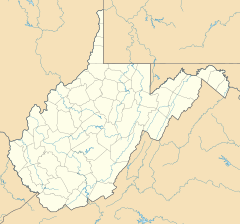Little Cacapon, West Virginia facts for kids
Quick facts for kids
Little Cacapon, West Virginia
|
|
|---|---|
| Country | United States |
| State | West Virginia |
| County | Hampshire |
| Elevation | 522 ft (159 m) |
| Time zone | UTC-5 (Eastern (EST)) |
| • Summer (DST) | UTC-4 (EDT) |
| Area code(s) | 304 |
| GNIS feature ID | 1554961 |
Little Cacapon is a small place in Hampshire County, West Virginia. It's called an unincorporated community, which means it's a group of homes and businesses that isn't officially a town or city with its own local government.
This community is found where the Little Cacapon River flows into the bigger Potomac River. It's located east of another place called Okonoko. Little Cacapon was very important in history because of its spot by the rivers and near the Baltimore and Ohio Railroad. It played a big part in both the French and Indian War and the American Civil War.
The name "Cacapon" comes from a Native American word meaning "medicine water." People usually say it like "kuh-KAY-pun."
Contents
Fort Cox: An Early Stronghold
Protecting the Potomac River
In 1765, a settler named Balzar Stoker received a large piece of land near the Little Cacapon River. This land was given to him by Thomas Fairfax, 6th Lord Fairfax of Cameron. Stoker also bought more land from a person named John Cox.
On this land, right where the Little Cacapon River meets the Potomac, there was a place called "Coxes Ferry." This ferry helped people cross the Potomac River into Maryland.
Building Cox's Fort
Before 1750, a relative of John Cox, named Friend Cox, built a strong wooden fence, or stockade, at the river's mouth. This stockade became known as Cox's Fort. Its main job was to protect the Potomac River and the valley around the Little Cacapon River.
Even George Washington had explored this area in 1750. Later, during the French and Indian War, Cox's Fort and the ferry were used by General Edward Braddock and his soldiers. They traveled through here on their way to Cumberland from Winchester.
Civil War Battles at Little Cacapon
The Important Railroad
By 1842, the Baltimore and Ohio Railroad was finished. It ran from Baltimore to Cumberland, following the Potomac River. This railway passed through places like Green Spring, Okonoko, and Little Cacapon.
When the American Civil War began in 1861, this railroad became a very important target. Both the Union (North) and the Confederacy (South) wanted to control it. Little Cacapon's location once again made it a key spot for defense.
Skirmishes and Captures
On November 30, 1861, a small fight, called a skirmish, happened near the Little Cacapon River. Soldiers were defending the railroad bridge there. Three Union soldiers were hurt in this fight.
A group of Union soldiers, Company K of the 54th Pennsylvania Volunteer Infantry Regiment, was assigned to guard the Baltimore and Ohio railroad bridge over the Little Cacapon. They stayed there until January 1863.
On October 4, 1862, another skirmish took place. Company K fought against Confederate soldiers led by General John D. Imboden. In this battle, 54 Union soldiers from Company K were captured. This included their leader, Captain Edmond R. Newhard, and Lieutenant Wagner.
Historic Site
- Cox's Fort Site is recognized as a historic place in Little Cacapon.



